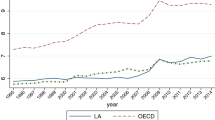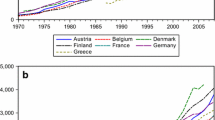Abstract
The aim of this paper is to investigate the relationship between health care expenditure (HCE) and economic growth and to the causality between HCE and economic growth in the selected South Asian Association for Regional Cooperation (SAARC) countries by employing the Panel cointegration and panel causality analysis over the period 1995–2012. Per capita income, labor force, literacy rate, and elderly population of age 65 and above are used an independent variables, as these variables are considered as main indicator of human and physical capital. For examining the time series properties of the data and long run relationships between HCE and economic growth, the panel unit root and panel cointegration tests are employed. The panel Dynamic Ordinary Least Squares (DOLS) method is used to estimate long run parameters, whereas the Seemingly Unrelated Regression (SUR) method is employed to estimate the short run parameters. For the panel causality among HCE and per capita GDP, a new technique developed by Dumitrescu and Hurlin (2012) is used. The results reveal that income elasticity of HCE is less than unity in the long run as well as in the short run. Furthermore, there is an evidence of unidirectional causality running from per capita GDP to HCE in the South Asian countries in the short run. Two-way causation between per capita GDP, labor force, literacy rate, and elderly population of age 65 and above is also observed. We also found two-way causality between labor force, elderly population of age 65 and health care expenditure.

Similar content being viewed by others
Notes
Under the HNC hypothesis non individual causality running from x to y occurs. In the HC and HEC cases, there is a causality relationship for each individual of the sample. Particularly, in the HC case, the same regression model is valid with identical parameters for all individuals, whereas this is not the case for the HEC hypothesis. Finally, causality relationship under HENC is heterogeneous because the variable x causes y only for a subsample of N − N 1 units (for further details see Dumitrescu and Hurlin 2012).
References
Ainsworth, M., & Over, M. (1994). AIDS and African development. World Bank Research Observer, 9, 203–240.
Akram, N., Padda, I.-H., & Khan, M. (2008). The long term impact of health on economic growth in Pakistan. The Pakistan Development Review, 47(4), 487–500.
Asghar, N., Awan, A., & Rehman, H. U. (2012). Human capital and economic growth in Pakistan: A cointegration and causality analysis. International Journal of Economics and Finance, 4(4), 135–147.
Baltagi, B. H., & Moscone, F. (2010). Health care expenditure and income in the OECD reconsidered: evidence from panel data. Economic Modelling, 27, 804–811.
Barro, R. J. (1991). Economic growth in a cross section of countries. Quarterly Journal of Economics, 196, 407–443.
Barro, R. J. (1996a). Determinants of economic growth: a cross-country empirical study. NBER Working Papers No. 5698.
Barro, R. (1996b). Three models of health and economic growth. Unpublished Manuscript. Cambridge, MA: Harvard University.
Barro, R. J., & Sala-i-Martin, X. X. (1992). Convergence Xavier Sala-i-Martin. Journal of Political Economics, 100, 223–251.
Barro, R., & Sala-I-Martin, X. (1995). Economic growth. New York: McGraw-Hill.
Barros, P. P. (1998). The black box of health care expenditure growth determinants. Health Economics, 7, 533–544.
Blomqvist, A. G., & Carter, R. A. (1997). Is health care really a luxury? Journal of Health Economins, 16(2), 207–229.
Bloom, D., & Canning, D. (2000). The health and wealth of nations. Science, 287, 1207–1209.
Bloom, D. E, Canning, D. E. & Sevilla, Y. (2001). The effect of health on economic growth: Theory and evidence. NBER Working Paper No. 8587, National Bureau of Economic Research1050 Massachusetts Avenue Cambridge, MA 02138.
Bukhari, S. A. H. A. S., & Butt, M. S. (2007). The direction of causality between health spending and GDP: the case of Pakistan. Journal of the Development of Economics, 45(1), 125–140.
Casasnovas, L. G., & Rivera, B. C. (2003). Health and economic growth: Findings and Policy Implications (pp. 1–25). Univiversity of Pompeu Fabra: Unpublished paper Department of Economics and Business.
Chou, W. L. (2007). Explaining China’s regional health expenditures using LM-type unit root tests. Journal of Health Economics, 26, 682–698.
Di Matteo, L. (2003). The income elasticity of health care spending. A comparison of parametric and nonparametric approaches. European Journal of Health Economics, 4(1), 20–29.
Dreger, C. and Reimers, H. E. (2005). Health care expenditures in OECD countries : A panel unit root and cointegration analysis. IZA Discussion paper No. 1469, Forschungsinstitut zur Zukunft der Arbeit Institute for the Study of Labor.
Dumitrescu, E.-I., & Hurlin, C. (2012). Testing for Granger non-causality in heterogeneous panels., Economic. Modelling, 29(4), 1450–1460.
Elk, R. van, Mot, E. & Franses, P. H. (2009). Modelling health care expenditures: Overview of the literature and the evidence from a panel time series model. CPB Discussion Paper No. 121, CPB Netherlands Bureau for Economic Policy Analysis, Van Stolkweg 14, P.O. Box 80510, 2508 GM The Hague, the Netherlands
Erdil, E., & Yetkiner, I. H. (2009). The Granger-causality between health care expenditure and output: a panel data approach. Applied Economics, pp., 511–518.
Freeman, D. G. (2003). Is health care a necessity or a luxury? Pooled estimates of income elasticity from US state-level data. Applied Economics, 35, 495–502.
Gerdtham, U.-G., & Jonsson, B. (1992). International comparisons of health care expenditure—conversion factor instability, heteroskedasticity, outliers and robust estimators. Journal of Health Economics, 11, 189–197.
Gerdtham, U. G., & Lothgren, M. (2000). On stationarity and cointegration of international health expenditure and GDP. Journal of Health Economics, 19(4), 461–475.
Gerdtham, U. G., & Lothgren, M. (2002). New panel results on cointegration of international health expenditure and GDP. Applied Economics, 34(3), 37–41.
Gerdtham, U. G., Søgaard, J., Andersson, F., & Jönsson, B. (1992). An econometric analysis of health care expenditure: A cross-section study of the OECD countries. Journal of Health Economics, 11(1), 63–84.
Gerdtham, U.G., Sögaard, J., MacFarlan, M. & Oxley, H. (1998). The determinants of health expenditure in the OECD countries, in: P. Zweifel (ed.), Health, the Medical Profession, and Regulation, Kluwer: 113-134.
Getzen, T. E. (2000). Health care is an individual necessity and a national luxury: applying multilevel decision models to the analysis of health care expenditures. Journal of HealthEconomics, 19(2), 259–270.
Government of Pakistan. (2012-13). Pakistan Economic Survey 2012-13. Economic Advisory’s Wing, Finance Division, Government of Pakistan.
Grossman, M. (1972). On the concept of health capital and the demand forhealth. Journal of Political Economy, 80, 223–255.
Haider, A., & Butt, S. M. (2007). The Direction of Causality between Health Spending and GDP: The Case of Pakistan. Pakistan Economic and Social Review, 45, 125–140.
Hansen, P., & King, A. (1996). The determinants of health care expenditure: A cointegration approach. Journal of Health Economics, 15(1), 127–137.
Hitiris, T., & Posnett, J. (1992). The determinants and effects of health expenditure in developed countries. Journal of Health Economics, 11, 173–181.
Im, K. S., Pesaran, M. H., & Shin, Y. (2003). Testing for unit roots in heterogeneous panels. Journal of Econometrics, 115(1), 53–74.
Jewell, T., Lee, J., Tieslau, M., & Strazicich, M. C. (2003). Stationarity of health expenditures and GDP: Evidence from panel unit root tests with heterogeneous structural breaks. Journal of Health Economics, 22(2), 313–323.
Jonsson, B., & Eckerlund, I. (2003). Why do different countries spend different amounts on health care? Paris: In ‘A Disease-based Comparison of Health Systems’ OECD.
Kao, C. (1999). Spurious regression and residual-based tests for cointegration in panel data. Journal of Econometrics, 90(1), 1–44.
Khan, M. A., & Khan, S. A. (2011). Foreign direct investment and economic growth in Pakistan: Sectoral analysis. PIDE Working Papers, 2011, 67.
Kleiman, E. (1974). The Determinants of National Outlay on Health. London: Macmillan.
Leu, R. R. (1986). Public and Private Health Services: Comptementarities and Conflicts. Basil Blackwell, Oxford: Chapter The Public–Private Mix and International Health Care Cost.
McCoskey, S., & Kao, C. (1998). A residual-based test of the null of cointegration in panel data. Econometric Reviews, 17, 57–84.
McCoskey, S. K., & Selden, T. M. (1998). Health care expenditures and GDP: Panel data unit root test results. Journal Health Economics, 17(3), 369–376.
Murthy, V., & Okunade, A. (2009). The core determinants of health expenditure in the African context: Some econometric evidence for policy. Health Policy, 91(1), 57–62.
Murthy, N. R. V., & Ukpolo, V. (1994). Aggregate health expenditure in the United States. Applied Economics, 26, 797–802.
Musgrove, P., Zeramdini, R., & Carrin, G. (2002). Basic patterns in national health expenditure. Bulletin of the World Health Organization, 80(2), 134–142.
Naeem, M., Nasir, A., Aman, Z., Ahmad, T., & Samad, A. (2008). Frequency of HER-2/NEU receptor positivity and its association with other features of breast cancer. Journal of Ayub Medical College, 20(3), 23–26.
Nelson, P. R., & Phelps, E. S. (1966). Investment in humans, technological diffusion, and economic growth. American Economic Review, 56(1,2), 69–75.
Newhouse, J. P. (1977). Medical care expenditure: a cross-national survey. Journal of Human Resources, 12, 115–125.
O’Connell, J. M. (1996). The relationship between health expenditures and the age structure of the population in OECD countries. Health Economics, 5, 573–578.
Okunade, A. A., & Karakus, M. C. (2001). Unit root and cointegration tests: Time series versus panel estimates for international health expenditure models. Applied Economics, 33(9), 1131–1137.
Okunade, A. A., Karakus, M. C., & Okeke, C. (2004). Determinants of health expenditure growth of the OECD countries: Jackknife resampling plan estimates. Health Care Management Science, 7(3), 173–183.
Olaniyan, O. (2013). Equity in health care expenditure in Nigeria. Internationl Journal of Finance and Banking Studies, 2(3). available at: http://www.ssbfnet.com/ojs/index.php/ijfbs/article/view/170/93.
Parkin, D., McGuire, A., & Yule, B. (1987). Aggregate health care expenditure and national income: Is health care a luxury good? Journal of Health Economics, 6, 109–127.
Pedroni, P. (1999). Critical values for co-integration tests in heterogeneous panels with multiple regressors.Oxford Bulletin of Economics and Statistics, Special Issue, 653-670.
Pedroni, P. (2004). Panel cointegration: Asymptotic and finite sample properties of pooled time series tests with an application to the PPP hypothesis. Econometric Theory, 20, 597–625.
Roberts, J. (1999). Sensitivity of elasticity estimates for OECD health care spending: analysis of a dynamic heterogeneous data field. Health Economics, 8, 459–472.
Romer, P. M. (1990). Endogenous technical change. Journal of Political Economy, 98(5), S71–S102.
Schieber, G., & Maeda, A. (1999). Health care financing and delivery in developing countries. Health Affairs, 18(3), 193–205.
Shahbaz, M., Iqbal, A., & Butt, M. S. (2011). Testing causality between hjuman development and economic growth: A panel data approach. International Journal of Education Economics and Development, 2(1), 90–102.
Shehzad, S. (2009). Pakistan’s food shortages and implications for health state and policy. Bangladesh Institute of International and Strategic Studies Journal, 30 (2). available at: http://www.biiss.org/BIISS_JOURNAL.phpfilename=journal/April2009_issue.html ISSN: 1010-9536.
Solow, R. M. (1956). A Contribution to the theory of economic growth. The Quarterly Journal of Economics, 70, 65–94.
van der Gaag, J., & Stimac, V. (2008). Towards a new paradigm for health sector development. Amsterdam: Amsterdam Institute for International Development.
Wilson, R. M. (1999). Medical care expenditures and GDP growth in OECD nations. American Association of Behavioral and Social Sciences Journal, 2, 159–171.
World Bank. (2014). World Development Indicators: World health system. Washington DC: The World Bank Group.
World Health Organization. (1999). The World Health Report 1999: Making a difference. World Health: Organization.
World Health Organization. (2014). World Health Statistics 2014. World Health: Organization.
Zafar, N. (2013). Does improvement in health leads toward economic growth: A case of SAARC countries. Journal of Global and Science Issues, 1, 25–29.
Zellner, A. & Sur, T. (1962). Seemingly unrelated regressions. Wikipedia.org.
Author information
Authors and Affiliations
Corresponding author
Rights and permissions
About this article
Cite this article
Khan, H.N., Khan, M.A., Razli, R.B. et al. Health Care Expenditure and Economic Growth in SAARC Countries (1995–2012): A Panel Causality Analysis. Applied Research Quality Life 11, 639–661 (2016). https://doi.org/10.1007/s11482-015-9385-z
Received:
Accepted:
Published:
Issue Date:
DOI: https://doi.org/10.1007/s11482-015-9385-z




